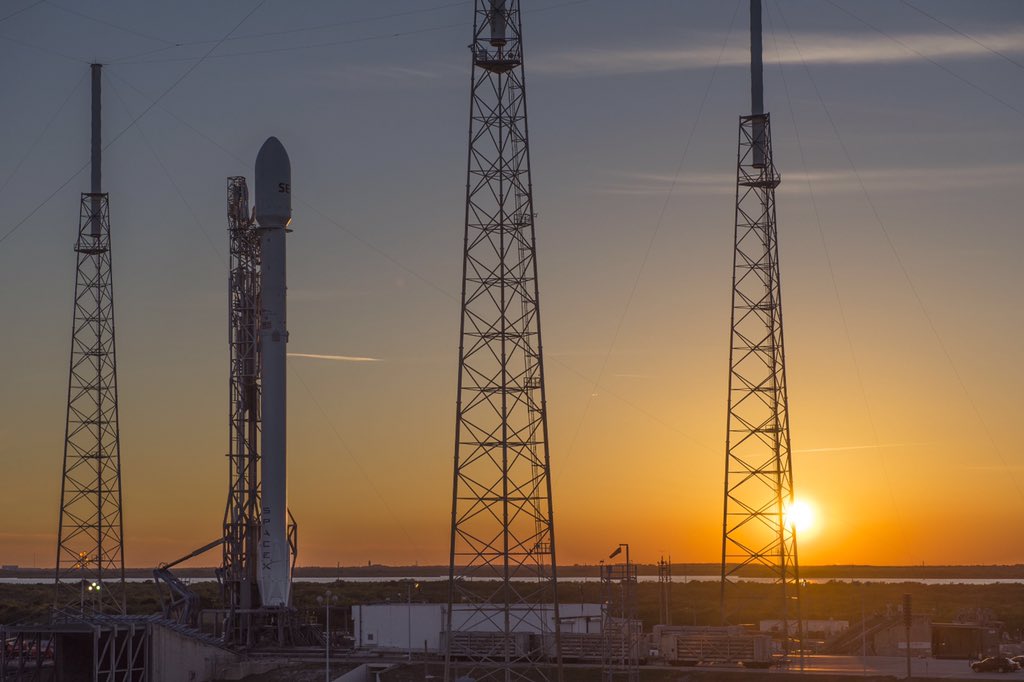
Editor's note: SpaceX has pushed the launch of the SES-9 commercial communications satellite — and the attempted landing of the first stage of the company's Falcon 9 rocket on a ship at sea — until Friday (March 4) because of high winds, according to SpaceX CEO and founder Elon Musk. The delay marks the fourth for the SES-9 mission, which was originally supposed to blast off on Feb. 24; below is Space.com's story about the most recent launch attempt, which was aborted just before liftoff Sunday (Feb. 28).
SpaceX aborted the launch of a commercial communications satellite less than a second before liftoff this evening (Feb. 28), delaying the mission yet again.
SpaceX's Falcon 9 rocket was scheduled to launch the SES-9 satellite from Cape Canaveral Air Force Station in Florida at 6:46 p.m. EST (2346 GMT) today, but that initial liftoff time was pushed back 35 minutes because a boat wandered into the mission's "keep-out zone," launch controllers said. At 7:21 p.m. EST (0021 GMT on Monday, Feb. 29), the Falcon 9's engines began firing up, but they shut down just as the countdown clock was reaching 0. .
The rocket may have been able to blast off today if not for the stray boat, SpaceX founder and CEO Elon Musk suggested.
"Launch aborted on low-thrust alarm. Rising oxygen temps due to hold for boat and helium bubble triggered alarm," Musk said today via his official Twitter account, @elonmusk.
The SES-9 mission — which also includes a daring attempt to fly the Falcon 9's first stage back to Earth for a soft landing on one of SpaceX's "autonomous spaceport drone ships" — has now been pushed back three separate times. Launch attempts on Wednesday and Thursday (Feb. 24 and Feb. 25) were scrubbed because of issues with the loading of liquid-oxygen propellant onto the rocket, company representatives said.
It's unclear when the next SES-9 launch attempt will be.
Get the Space.com Newsletter
Breaking space news, the latest updates on rocket launches, skywatching events and more!
"We don't have another launch date planned at the moment," Falcon 9 product director John Insprucker said during the launch webcast today.
"We're going to have to continue to evaluate the first-stage telemetry that we have," he added. "The Falcon 9 is safe; the vehicle went through a standard recovery sequence that we've used many times."
The Falcon 9 will deliver SES-9 to geostationary transfer orbit for SpaceX customer SES, a company based in Luxembourg. The rocket-landing attempt is a secondary objective; it is part of SpaceX's effort to develop fully and rapidly reusable launch vehicles, a key priority for Musk and the company.
SpaceX has tried drone-ship landings three times before — in January 2015, April 2015 and January 2016. Each time, the Falcon 9 first stage hit its target but ended up falling over and exploding on the ship's deck.
A Falcon 9 has landed successfully on terra firma; SpaceX pulled off this milestone in December 2015 at Cape Canaveral.
Follow Mike Wall on Twitter @michaeldwall and Google+. Follow us @Spacedotcom, Facebook or Google+. Originally published on Space.com.
Join our Space Forums to keep talking space on the latest missions, night sky and more! And if you have a news tip, correction or comment, let us know at: community@space.com.

Michael Wall is a Senior Space Writer with Space.com and joined the team in 2010. He primarily covers exoplanets, spaceflight and military space, but has been known to dabble in the space art beat. His book about the search for alien life, "Out There," was published on Nov. 13, 2018. Before becoming a science writer, Michael worked as a herpetologist and wildlife biologist. He has a Ph.D. in evolutionary biology from the University of Sydney, Australia, a bachelor's degree from the University of Arizona, and a graduate certificate in science writing from the University of California, Santa Cruz. To find out what his latest project is, you can follow Michael on Twitter.









